B. Differential Leveling
1. Principle
Differential leveling uses the vertical distance difference between two points to transfer an elevation from one point to another.
A summary of the process:
A Level is setup between two points, one whose elevation is known, Figure B-1.
 |
| Figure B-1 Setting Up |
A backsight (BS) reading is taken on the known point, Figure B-2, using a rod divided into feet (or meters) and subdivisions thereof. This determines how far above the LoS is above the known point. Adding the BS reading to the point elevation gives the elevation of the instrument (EI, aka, Height of the Instrument, HI).
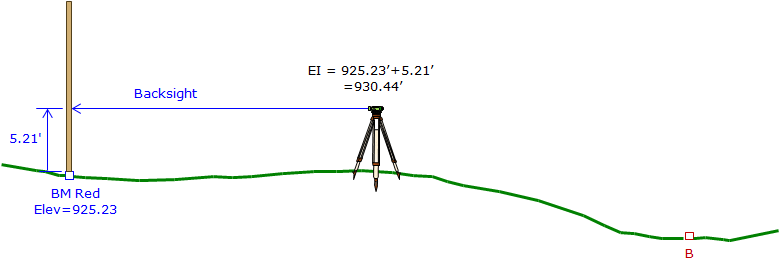 |
| Figure B-2 Backsight Reading |
A foresight (FS) reading is taken on the unknown point, Figure B-3, to determine how far above it the LoS is. Subtracting the FS reading from the instrument elevation gives the point elevation.
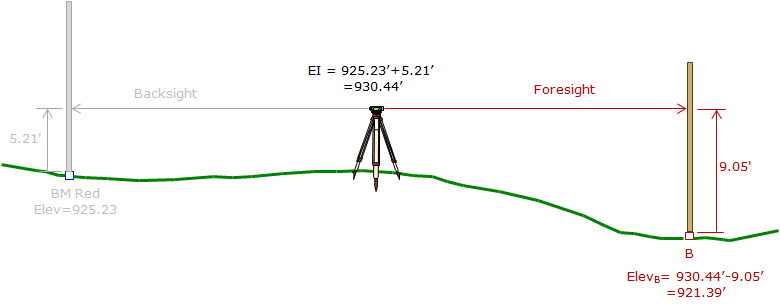 |
| Figure B-3 Foresight Reading |
The elevation of B is determined by adding the difference between the BS and FS readings:
ElevB = ElevRed+(BSRed-FSB)
The instrument is moved to a position between B and the next point and the process repeated.
2. Equipment
The equipment list for differential leveling minimally includes:
- Level instrument
- Tripod
- Level rod
Although not always needed, a rod bubble and turning pin or turtle are often included.
a. Level Instrument
A level instrument is a telescope mounted so that it can be oriented horizontally.
(1) Traditional
Traditional levels are four-screw instruments. This refers to the four screws at the leveling head which are used to level the instrument. These levels typically have a long telescope and a bubble vial with a high sensitivity bubble. The higher the bubble sensitivity, the more quickly it reacts to level screw adjustment. A sensitive bubble is necessary to accurately establish a horizontal LoS. Four-screw instruments are either a Dumpy or Wye type.
A Dumpy level, Figure B-4, is the simpler of the two. Its telescope and bubble vial are rigidly attached to the upper part of the instrument. This upper part can be rotated horizontally and has a lock and slow motion for fine pointing.
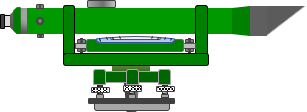 |
| Figure B-4 Dumpy Level |
One or both ends of the bubble vial have screws or nuts allowing the ABT to be adjusted.
A Wye level is similar to a Dumpy except the telescope, including the bubble tube, is clamped in a pair of Y-shaped saddles (wyes), Figure B-5.
 |
| Figure B-5 Wye Level |
When the clamps are opened, the telescope and bubble can be removed, Figure B-6.
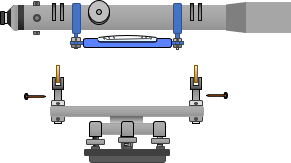 |
| Figure B-6 Opened Wye Level |
The telescope can be turned end for end and replaced. This capability is not used while running a level circuit. So what is it for? It is primarily used as another way to check and adjust the instrument.
Of the two, the Dumpy level was more common and produced up through the 1980s.
All four leveling screws must be snugly in contact with the leveling head or the instrument will wobble. During instrument leveling, diagonal screws are turned opposite each other to center the bubble. Screws are easily under- or over-tightened. An under-tightened screw will cause the instrument to rock on the leveling head. Over-tightening will make the screw motions stiff and possibly warp the leveling head.
Because the bubble is so sensitive, slight screw rotations can cause considerable bubble movement. The surveyor can waste time "chasing the bubble" and use a single screw for minor adjustment, which in turn, contributes to under- and over-tightening.
These contribute to make instrument setup frustrating for the novice surveyor. While initially challenging, setup becomes easier and more efficient with practice.
(2) Automatic
The most common modern instrument is an Automatic level, Figure B-7.
 |
|
Figure B-7 |
It is a three-screw instrument making it impossible for the instrument to wobble like a four-screw instrument can.
The automatic level gets its name from an internal compensation system which automatically maintains a horizontal LoS if the instrument is disturbed. The compensation system uses a combination of fixed and free swinging prisms and mirrors. When the instrument is tilted the compensation system reacts to maintain a horizontal sight line at the observer’s end. The stylized cross-sectional views in Figure B-8 shows how the incoming horizontal LoS is reflected and refracted and emerges at the eyepiece in a parallel path.
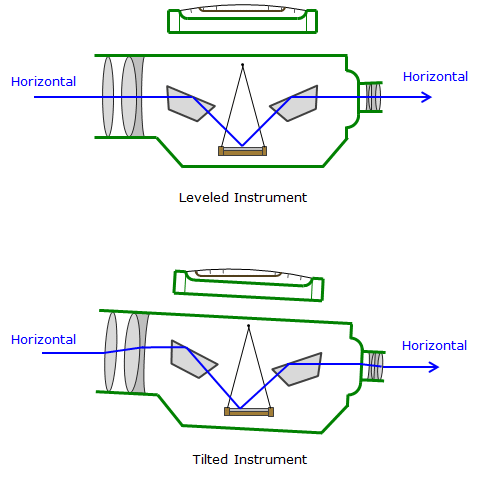 |
| Figure B-8 Compensator Reacting |
The instrument is leveled using a circular bubble. The etched circle on the bubble glass is a general indicator of the compensator's operating range. If the bubble is outside the circle, the compensator may be at its physical limit and unable to maintain a horizontal LoS.
b. Tripod
A tripod is a three-legged support platform for the level, Figure B-9. The tripod's primary material can be wood, metal, fiberglass, or plastic; its legs fixed length or extendable. It usually has a flat top and a mounting screw for instrument attachment. The tripod’s function is to ensure a stable instrument setup for reliable measurements.
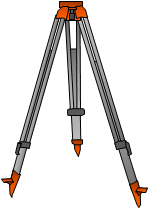 |
| Figure B-9 Tripod |
c. Level Rod
A level rod is a tall linear measuring scale. In English units, the divisions may be feet and decimal feet or feet-inches and fractional inches. Feet and decimal feet are most commonly used. In the metric system the divisions are meters and decimal meters.
The rod can be constructed of wood, metal, or fiberglass. Most rods telescope or extend in order to allow large elevation difference determinations yet collapse into a compact form.
There are many width and gradation styles depending on application. The most universal design is the Philadelphia rod, a portion of which is shown in Figure B-10.
 |
Red numbers are the full foot readings. Black numbers are the 0.1 ft readings The bars are each 0.01 ft tall and spaced 0.01 ft apart. Peaks on the bars correspond to the adjacent 0.1 or foot reading. A peak without an adjacent number corresponds to a half-tenth or 0.05 ft. At distances up to about 300 feet, a Philadelphia rod can be read directly to 0.01 ft. |
| Figure B-10 Level Rod |
Reading a rod consists of identifying the full foot and tenth foot, then counting up or down to determine the hundredth foot.
Figure B-11 shows some example rod readings.
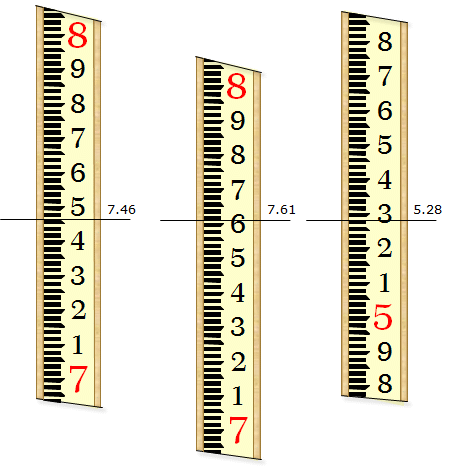 |
| Figure B-11 Example Rod Readings |
The reading must be made with the rod held vertically to correctly determine instrument height above a point. There are a few ways to ensure the rod is vertical when the reading is made.
One method is to use a rod bubble, Figure B-12. This is a circular bubble which is held against or mounted to a level rod. The rod is vertical when the bubble is centered.
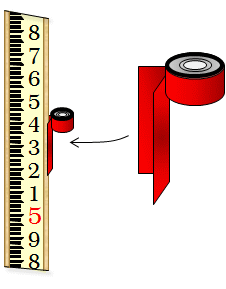 |
| Figure B-12 Rod Bubble |
If a rod bubble is not available, then the rod can be waved, or rocked, slowly back and forth, Figure B-13.
The instrument operator will see the rod reading increase and decrease as the rod is waved. The reading is too high when the rod is tilted forward or backward. It is lowest when the rod is vertical. The operator records that reading.
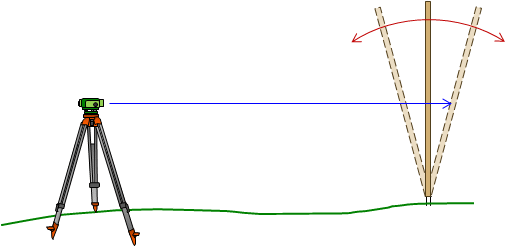 |
| Figure B-13 Waving the Rod |
d. Turning point
Often when running a level line the distances between points may be too long for reliable reading or there may be obstructions. In such cases intermediate temporary points are established and leveled through. If a suitable stable point is not available then a turning point is used.
A turning point is usually a steel pin with a rounded top which can be firmly pounded into the ground, Figure B-14. It is left in position until after a BS reading is taken on it and the next elevation point established. Only then is it safe to remove the pin since its elevation is no longer needed.
Where the surface is hard, making it difficult to pound in a pin, a turtle can be used instead. A turtle is a heavy triangular or circular steel plate with three short equally spaced legs and a short rounded pin at top center, Figure B-15. When placed, the weight of the turtle helps keep it relatively stable while readings are taken. On some surfaces, dropping the turtle helps seat its legs more firmly providing additional stability.
 |
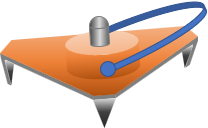 |
|
| Figure B-14 Turning Point |
Figure B-15 Turtle |